Collegeboard MCQ Corrections
Collegeboard MCQ Test Corrections, reflection.
- AP CSP Study Summary
- 5 Bullet Point Score Reflection:
- CPT and PPR Preparationsions
- MCQ REFLECTION:
- Analysis of Duplicate Removal Code Question
- Analysis of Binary Search Question# Analysis of Binary Search Question
- Analysis of Algorithmic Problem Solving Questionlving Question
- Analysis of Filtering and Sorting Restaurant Data Question# Analysis of Filtering and Sorting Restaurant Data Question
- Analysis of Nested Conditional Display Values Question# Analysis of Nested Conditional Display Values Question
- Analysis of Science Simulation Error Question
- Analysis of Iteration Statement Question
- Analysis of Network Communication Questionnalysis of Network Communication Question
- Analysis of “Error in isIncreasing procedure” Questionnalysis of “Error in isIncreasing procedure” Question
AP CSP Study Summary
- I will review all key topics outlined in the AP CSP curriculum, focusing on areas like algorithms, data structures, and abstraction.
- I will practice solving multiple-choice questions and writing free-response answers from past AP exams to familiarize myself with the test format.
- I will focus on understanding the concepts behind each computational thinking skill, especially programming, problem-solving, and data analysis.
- I will make sure to practice coding regularly, using tools like Scratch, Java, or Python, to improve my ability to write efficient code.
- I will use study groups or online resources to discuss difficult concepts and clarify any confusion I may have about specific topics.
5 Bullet Point Score Reflection:
-
Strength in Identifying Correct Answers: Demonstrated a solid understanding of computational concepts by correctly identifying why specific answers are correct, such as the time complexity of binary search and the proper use of conditional logic.
-
Improvement in Error Analysis: Effectively analyzed why incorrect answers fail, such as recognizing logical contradictions or flaws in algorithmic assumptions, showcasing growth in critical thinking.
-
Focus on Algorithmic Understanding: Highlighted the importance of understanding algorithmic efficiency and problem-solving limitations, reflecting a deeper grasp of computational thinking.
-
Attention to Procedural Logic: Successfully identified procedural errors, such as the need to adjust loop conditions or sequence operations, indicating improved debugging skills.
-
Commitment to Study Goals: Maintained alignment with study strategies, including practicing coding, reviewing key topics, and leveraging study groups, ensuring consistent progress toward AP CSP readiness.
CPT and PPR Preparationsions
- Strength in Understanding Requirements: I have demonstrated a strong ability to review and align my work with guidelines and rubrics, ensuring that all criteria are met effectively. I should continue to carefully analyze requirements and double-check my work against them.
- Weakness in Time Management: While I have planned my study and work effectively, I need to focus on adhering to a strict timeline for completing each component to avoid last-minute rushes. Setting smaller, actionable deadlines could help me improve in this area.
- Strength in Coding Proficiency: My regular coding practice has enhanced my ability to implement algorithms and debug efficiently, which is a key skill for the CPT. I should maintain this habit and challenge myself with more complex problems to further strengthen my skills.
- Weakness in Testing Thoroughness: While I test my programs, I need to focus on improving the depth and variety of test cases to ensure my program handles edge cases effectively. I should make it a priority to design comprehensive test plans for my projects.
- Strength in Reflection and Revision: My focus on writing clear responses and revising based on feedback shows my commitment to producing high-quality written components. I should continue to seek constructive feedback and use it to refine my work.
General: Generally when going into any CPT and PPR questions, I’m gonna have to refference my past projects I worked with individually and as a general group. However questions including some from the PPR would be more inconsistent for me as some parts are incomplete while others are consistent, and could be better pollished for understanding such as adding comments and ideations to my code.
MCQ REFLECTION:

Analysis of Duplicate Removal Code Question
Summary
- Why A is incorrect: The first and last 10s are separated by other values. The code only removes adjacent duplicates, so not all duplicates are removed. and last 10s are separated by other values. The code only removes adjacent duplicates, so not all duplicates are removed.
- Why C is correct: Duplicates (40) are not adjacent, so the code does not remove both instances. not remove both instances.
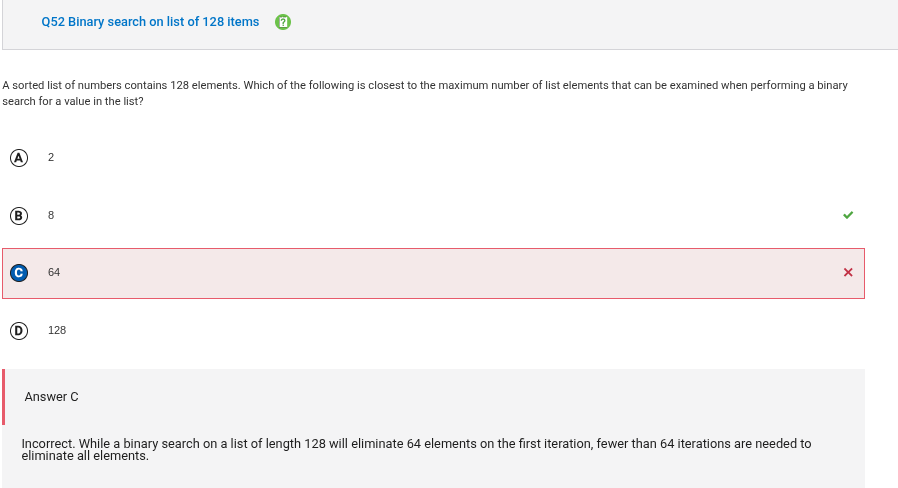

Analysis of Binary Search Question# Analysis of Binary Search Question
Summary
- Why D is incorrect: Binary search is efficient because it eliminates half of the remaining list on each step. It never checks all 128 items. arch is efficient because it eliminates half of the remaining list on each step. It never checks all 128 items.
- Why B is correct: Binary search has a worst-case time complexity of log₂(n). For a list of 128 items, log₂(128) = 7, so a maximum of 7 comparisons are needed. Rounding up, the closest valid choice is 8.are needed. Rounding up, the closest valid choice is 8.
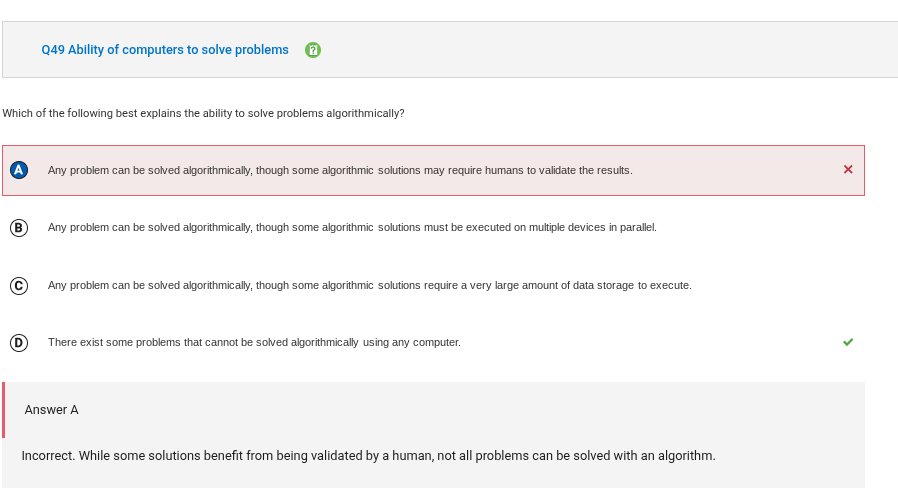 00”>
00”>
Analysis of Algorithmic Problem Solving Questionlving Question
Summary
- Why A is incorrect: It falsely assumes every problem is solvable by an algorithm, which is not true. ncorrect:** It falsely assumes every problem is solvable by an algorithm, which is not true.
- Why D is correct: It reflects the reality that some problems are beyond the reach of algorithms, no matter how powerful the computer. algorithms, no matter how powerful the computer.
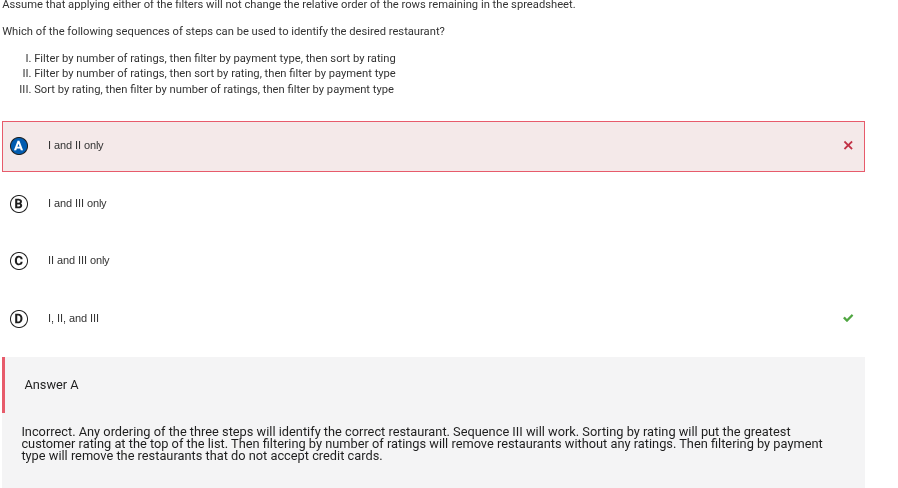

Analysis of Filtering and Sorting Restaurant Data Question# Analysis of Filtering and Sorting Restaurant Data Question
Summary
- Why A is incorrect: It wrongly excludes sequence III, assuming sorting must come after filtering. t:** It wrongly excludes sequence III, assuming sorting must come after filtering.
- Why D is correct: All three sequences logically filter out irrelevant entries and sort the results correctly. Sorting before filtering is acceptable when the filters maintain row order.ies and sort the results correctly. Sorting before filtering is acceptable when the filters maintain row order.
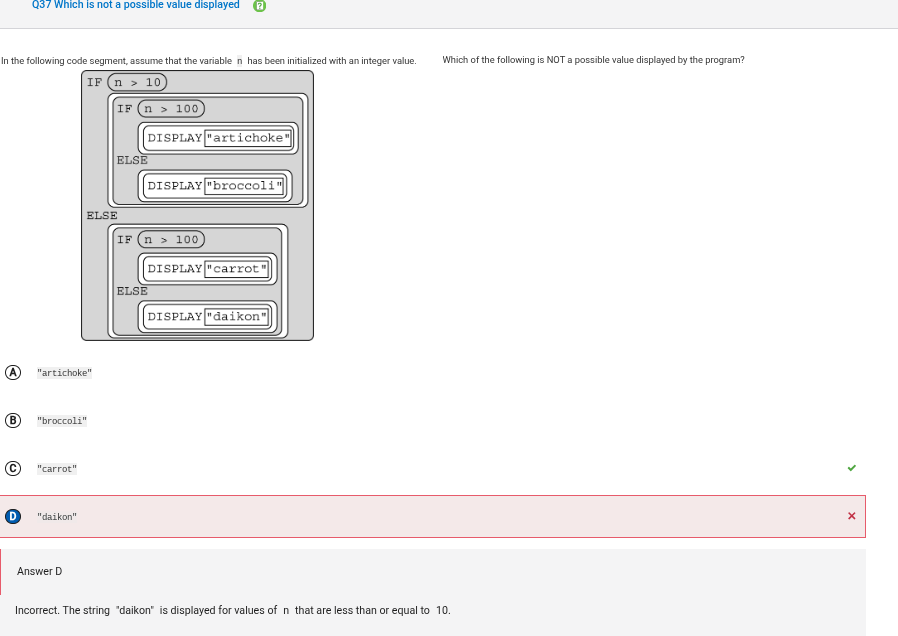

Analysis of Nested Conditional Display Values Question# Analysis of Nested Conditional Display Values Question
Summary## Summary
- Why D is incorrect:
"daikon"can be displayed whenn <= 10, falling through to the correctELSEblock. - Why D is incorrect:"daikon"can be displayed whenn <= 10, falling through to the correctELSEblock. - Why C is correct:
"carrot"requires a logical contradiction and is never a valid output.*Why C is correct:**"carrot"requires a logical contradiction and is never a valid output.
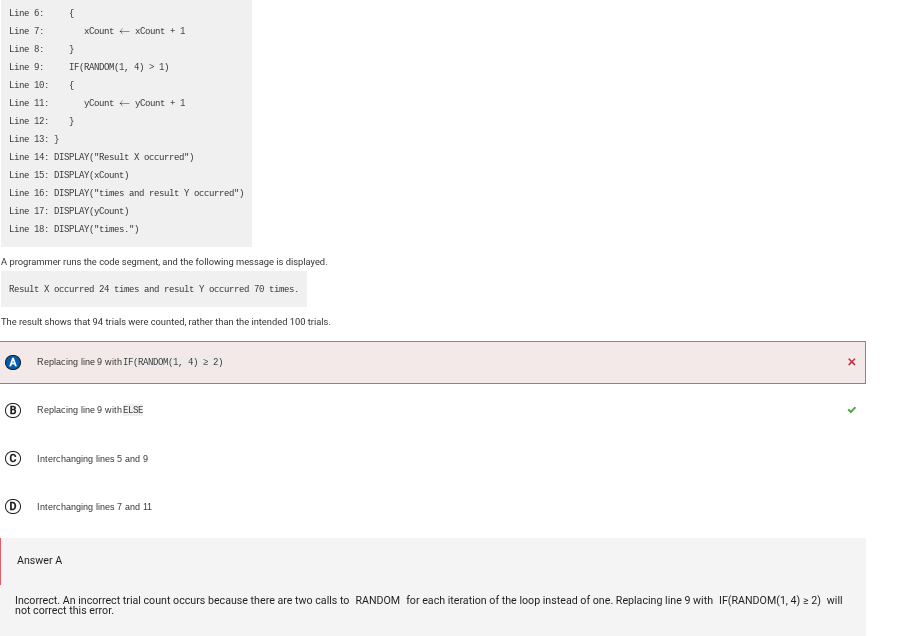 lt=”Question 34: Error in science simulation, 4.C” width=”600” height=”400”>
lt=”Question 34: Error in science simulation, 4.C” width=”600” height=”400”>
Analysis of Science Simulation Error Question
Summary
- Why A is incorrect: Changing the condition does not address the root problem of double counting due to two separate random calls.
- Why B is correct: Using
ELSEensures that only one result (X or Y) occurs in each iteration, resulting in the correct number of trials (100).- Why B is correct: UsingELSEensures that only one result (X or Y) occurs in each iteration, resulting in the correct number of trials (100).
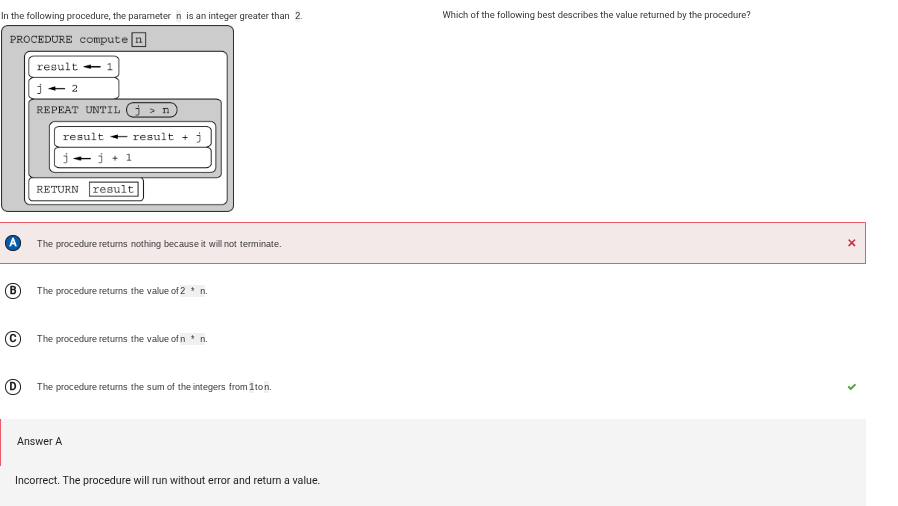

Analysis of Iteration Statement Question
Summary
- Why A is incorrect: The procedure does not fail to terminate; it terminates after adding the value of
2toresultand incrementingj. *Why A is incorrect:** The procedure does not fail to terminate; it terminates after adding the value of2toresultand incrementingj. - Why D is correct: The procedure calculates the sum of integers from 1 to
nby adding each value ofjin the loop.- Why D is correct: The procedure calculates the sum of integers from 1 tonby adding each value ofjin the loop.
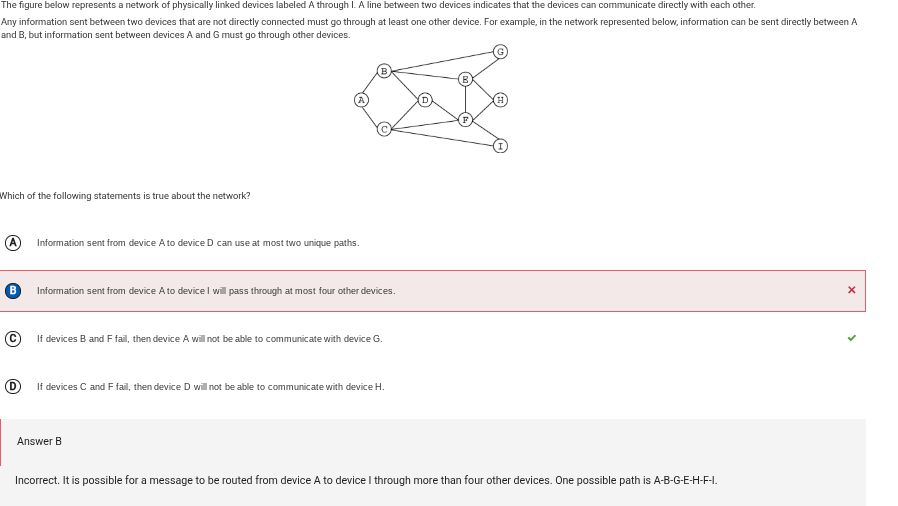
Analysis of Network Communication Questionnalysis of Network Communication Question
Summary
- Why B is incorrect: The path from A to I can go through more than four devices, as demonstrated by a longer possible route. - Why B is incorrect: The path from A to I can go through more than four devices, as demonstrated by a longer possible route.
- Why D is correct: The failure of C and F blocks the direct communication path between D and H, as F is a critical link in the path.ks the direct communication path between D and H, as F is a critical link in the path.

Analysis of “Error in isIncreasing procedure” Questionnalysis of “Error in isIncreasing procedure” Question
Summary
- Why A is incorrect: Changing the starting count to 1 would lead to an invalid list index, causing errors. The starting count should be 2 to compare the second element with the first. , causing errors. The starting count should be 2 to compare the second element with the first.
- Why D is correct: Interchanging lines 10 and 11 ensures that the next list element is properly checked in each iteration, making the procedure work as intended. making the procedure work as intended.